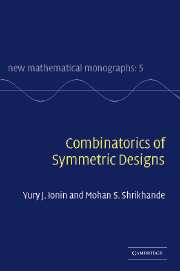Book contents
- Frontmatter
- Contents
- Preface
- 1 Combinatorics of finite sets
- 2 Introduction to designs
- 3 Vector spaces over finite fields
- 4 Hadamard matrices
- 5 Resolvable designs
- 6 Symmetric designs and t-designs
- 7 Symmetric designs and regular graphs
- 8 Block intersection structure of designs
- 9 Difference sets
- 10 Balanced generalized weighing matrices
- 11 Decomposable symmetric designs
- 12 Subdesigns of symmetric designs
- 13 Non-embeddable quasi-residual designs
- 14 Ryser designs
- Appendix
- References
- Index
13 - Non-embeddable quasi-residual designs
Published online by Cambridge University Press: 26 February 2010
- Frontmatter
- Contents
- Preface
- 1 Combinatorics of finite sets
- 2 Introduction to designs
- 3 Vector spaces over finite fields
- 4 Hadamard matrices
- 5 Resolvable designs
- 6 Symmetric designs and t-designs
- 7 Symmetric designs and regular graphs
- 8 Block intersection structure of designs
- 9 Difference sets
- 10 Balanced generalized weighing matrices
- 11 Decomposable symmetric designs
- 12 Subdesigns of symmetric designs
- 13 Non-embeddable quasi-residual designs
- 14 Ryser designs
- Appendix
- References
- Index
Summary
Quasi-residual designs can be useful in constructing symmetric designs. However, there are quasi-residual designs that cannot be embedded in a symmetric design. This may happen because the corresponding symmetric design does not exist. Another reason for nonembeddability could be the existence of several blocks whose intersection sizes do not allow them to be extended to blocks of a symmetric design. Also, a quasi-residual design may have a substructure preventing it from embeddability in a symmetric design.
Quasi-residuals of non-existing symmetric designs
Recall that a (v, b, r, k, λ)-design is called quasi-residual if r = k + λ. This condition is satisfied by any residual design of a symmetric (v + r, r, λ)-design. If a quasi-residual design is isomorphic to a residual of a symmetric design D, it is said to be embeddable inD. In this section we will construct several families of quasi-residual (v, b, r, k, λ)-designs for which a symmetric (v + r, r, λ)-design does not exist.
To obtain the first family of such designs, let D be the (v – 1)-fold multiple of the complete symmetric (v, v – 1, v – 2)-design. Then D is a (v, v(v – 1), (v – 1)2, v – 1, (v – 1)(v – 2))-design, so D is quasi-residual. If D is embeddable in a symmetric design, then the complement of this symmetric design is a projective plane of order v – 1. Nowthe Bruck–Ryser Theorem gives an infinite family of non-embeddable quasi-residual designs.
- Type
- Chapter
- Information
- Combinatorics of Symmetric Designs , pp. 429 - 446Publisher: Cambridge University PressPrint publication year: 2006



